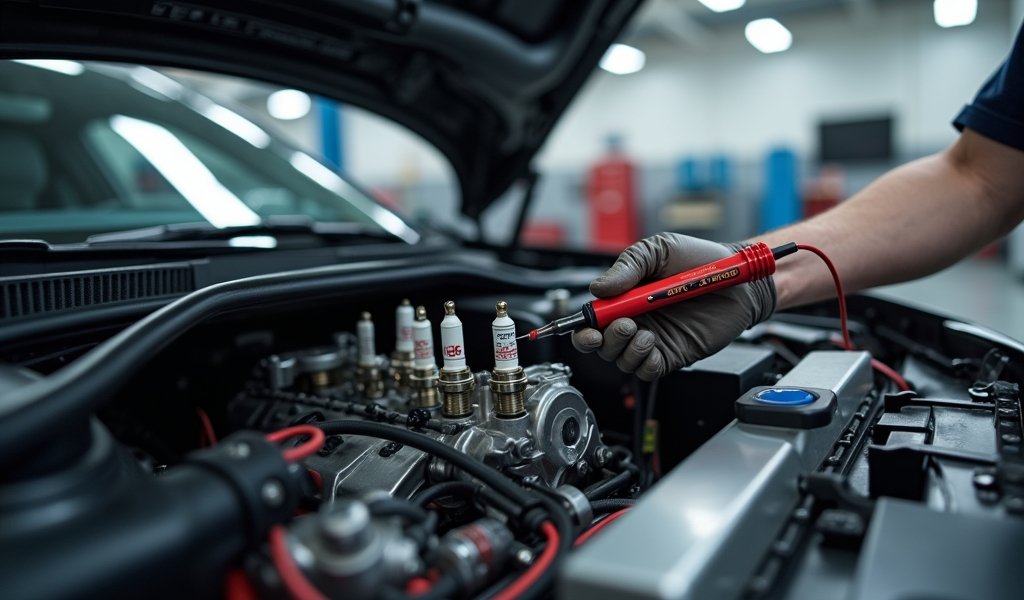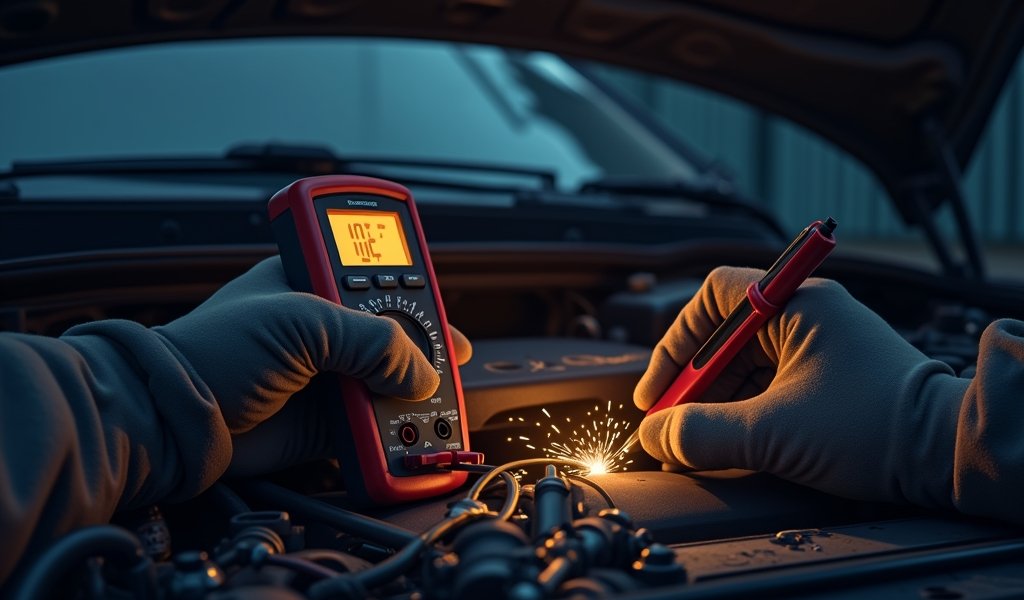Overview
This article explains how to test spark plug wire resistance using a multimeter to diagnose engine performance issues, with normal readings typically between 3,000-15,000 ohms per foot depending on wire type. It covers signs of failing wires (misfires, rough idling, poor fuel economy), testing techniques both with and without specialized tools, and maintenance tips to extend wire life, emphasizing that consistent readings between wires are often more important than absolute values.
Table of Contents
- Why Testing Spark Plug Wire Resistance Matters
- Signs Your Spark Plug Wires Need Attention
- Essential Tools for Spark Plug Wire Testing
- Step-by-Step Guide to Testing Spark Plug Wire Resistance
- What Are Normal Resistance Readings?
- No Multimeter? Try These Testing Hacks
- Advanced Testing Techniques for Thorough Diagnostics
- Troubleshooting Common Resistance Problems
- DIY Fixes vs. When to Replace
- Maintenance Tips for Longer Wire Life
- Conclusion
- Frequently Asked Questions
Your car’s engine is like a symphony orchestra, with each component playing its unique part in creating the perfect harmony of power and efficiency. Among these vital components, spark plug wires often serve as the unsung heroes – silently transferring thousands of volts of electricity from your ignition coil to your spark plugs. When these crucial conductors begin to fail, your engine’s performance quickly transforms from a beautiful melody to a discordant mess.
Why Testing Spark Plug Wire Resistance Matters
Think of spark plug wires as the blood vessels of your ignition system. Just like clogged arteries restrict blood flow to your heart, high-resistance spark plug wires restrict electrical flow to your spark plugs. This restriction means weaker sparks, incomplete combustion, and ultimately, an engine that struggles to perform.
On the flip side, wires with too little resistance can create their own problems. They’re like fire hoses with too much pressure – prone to causing electromagnetic interference that can disrupt everything from your radio to your engine management system. This delicate balance is why spark plug wire resistance testing is so crucial to your vehicle’s health.
I’ve seen countless engines brought back to life with nothing more than a fresh set of properly functioning wires. One customer’s truck had been to three different shops with persistent misfires – none thought to check wire resistance. A simple test revealed one wire with resistance readings off the charts, and a $50 wire set solved what others had quoted hundreds to fix.
Signs Your Spark Plug Wires Need Attention
Your car has a way of whispering (or sometimes shouting) when something’s wrong. When it comes to spark plug wire issues, be on the lookout for these telltale symptoms:
- Engine misfires or hesitation during acceleration
- Rough idling that feels like the engine wants to stall
- Decreased fuel economy (your wallet notices this one)
- Hard starting, especially in damp weather
- Check Engine Light illumination with misfire codes
- Radio interference that changes with engine RPM
These symptoms are your engine’s way of raising a red flag. Think of spark plug wire resistance testing as the diagnostic tool that helps you decode what your car is trying to tell you. It’s like having a conversation with your vehicle about what hurts and how to fix it.

Essential Tools for Spark Plug Wire Testing
Just as a doctor needs a stethoscope, you’ll need the right tools to diagnose spark plug wire issues properly. Here’s what should be in your diagnostic toolkit:
Digital Multimeter
This is your MVT (Most Valuable Tool) for spark plug wire resistance testing. Look for one with an ohm (Ω) setting that can measure in the kilohm range. You don’t need to break the bank – a basic model from a hardware store (around $20-40) will serve home mechanics perfectly well. Professional-grade models offer more features but aren’t necessary for occasional testing.
Wire Removal Tools
Never yank wires by the cables! Proper boot puller tools (usually under $10) help you remove spark plug wire boots without damaging the delicate internal components. Your future self will thank you for this small investment.
Dielectric Grease
While not technically a testing tool, having dielectric grease on hand is smart for when you reconnect wires. It prevents moisture ingress and ensures good electrical contact – both factors that can affect resistance readings over time.
For those who work on ignition systems regularly, specialized spark plug wire testers offer additional convenience. These purpose-built tools often provide quicker readings and can test for insulation leaks as well as resistance. Professional mechanics often prefer these dedicated testers for their accuracy and ease of use.
Step-by-Step Guide to Testing Spark Plug Wire Resistance
Testing your spark plug wires’ resistance is simpler than many people think. Follow these steps and you’ll be diagnosing like a pro in no time:
- Prep work: Ensure the engine is completely cool and the ignition is off. Safety first!
- Set up your multimeter: Select the ohm (Ω) setting. Most automotive wires will read in the kilohm (kΩ) range.
- Access your wires: For easier testing, disconnect one end of the wire (preferably at the distributor or coil pack end).
- Test each wire: Place one multimeter probe at each end of the disconnected wire. Hold firmly to ensure good contact.
- Record results: Note the resistance reading for each wire. Consistency between wires is often as important as the actual values.
- Repeat the process: Test each wire individually and compare the results.
Think of this process as taking your engine’s pulse – you’re looking for regularity and readings within a healthy range. If one wire shows significantly different resistance than the others, you’ve likely found your culprit.
One mechanic’s trick I’ve learned over years in the shop: mark each wire with masking tape and a number as you test it. This prevents confusion when working with multiple wires and helps you track readings methodically. Small organizational habits like this save enormous headaches, especially on engines with eight or more cylinders.
What Are Normal Resistance Readings?
Knowing what’s “normal” is crucial when interpreting your test results. Spark plug wire resistance isn’t a one-size-fits-all measurement – it varies by wire type and construction:
- Standard copper core wires: Typically 3,000-8,000 ohms per foot
- Carbon-core/resistor wires: Usually 10,000-15,000 ohms per foot
- Performance wires (low resistance): Often 40-50 ohms per foot
Your vehicle’s service manual provides the exact specifications for your specific model. When these resources aren’t available, a good rule of thumb is that most modern cars use carbon-core wires with resistance between 3,000 and 12,000 ohms for the entire wire length.
What matters most is consistency. If seven wires measure around 7,000 ohms and one measures 20,000 ohms, that outlier is almost certainly your problem child – even if technically within some acceptable ranges. Consistency between cylinders often tells you more than the absolute numbers.
I once diagnosed a persistent misfire on a Chevrolet that had stumped another mechanic. Seven wires measured between 5,000-6,000 ohms, while the eighth showed 25,000 ohms. Despite being within the manufacturer’s maximum allowable resistance, this outlier was causing the cylinder to misfire under load. A properly gapped spark plug and new wire solved the problem immediately.

No Multimeter? Try These Testing Hacks
Sometimes you’re troubleshooting without your trusty multimeter. Maybe you’re stranded roadside or working in your driveway without access to your tools. Fear not! These field-expedient techniques can help identify problematic wires:
The Darkness Test
In a darkened garage at night, start your engine and carefully observe the spark plug wires. Faulty insulation or high resistance will often produce visible blue sparks jumping from the wire to nearby metal components. Think of it as watching for lightning in a miniature electrical storm.
The Spray Bottle Method
With the engine running, lightly mist the spark plug wires with a spray bottle of clean water. If you hear a sudden change in engine idle or see arcing, you’ve found a wire with compromised insulation. The water creates a path for the high voltage to escape through damaged insulation.
The Wire Swap Test
If your engine has a misfire in a specific cylinder, try swapping that cylinder’s wire with another cylinder. If the misfire “follows” the wire to the new cylinder, you’ve confirmed the wire is at fault. This is similar to how doctors might change one medication at a time to identify which one causes a side effect.
While these techniques don’t specifically test resistance values, they can help you pinpoint problematic wires when proper testing equipment isn’t available. Consider them your “MacGyver methods” for emergency diagnostics.
A mechanic I trained under called these “squint and listen” techniques – sometimes your eyes and ears can tell you as much as fancy equipment. He diagnosed countless ignition problems using nothing more sophisticated than a spray bottle and a darkened garage. Even professional manufacturers recognize the value of these time-tested diagnostic approaches.
Advanced Testing Techniques for Thorough Diagnostics
For those who want to dive deeper into spark plug wire diagnostics, these advanced techniques can reveal problems that standard resistance testing might miss:
Dynamic Testing Under Load
Static resistance testing (engine off) tells only part of the story. Problems often appear only under the stress of actual operation:
- Connect an adjustable spark tester between the wire and spark plug
- Start the engine and watch the spark quality
- Observe for consistent, strong spark as you increase engine RPM
A wire might show acceptable resistance when cold but develop problems once hot. This real-world testing often reveals issues static testing misses.
Temperature-Related Testing
Many spark plug wire failures are temperature-dependent. Try this approach:
- Test all wires when the engine is cold
- Run the engine until it reaches operating temperature
- Quickly retest the wires while hot
- Compare the readings – failing wires often show dramatically increased resistance when hot
I’ve encountered numerous vehicles where wires tested fine when cold but showed resistance increasing by 500% or more at operating temperature. No wonder these vehicles ran perfectly for the first ten minutes, then developed misfires on the highway!
For those with access to professional equipment, resistance testing of other sensors in conjunction with spark plug wires can provide a complete picture of your ignition system’s health. This comprehensive approach often reveals how multiple components interact to create drivability issues.
Troubleshooting Common Resistance Problems
When your testing reveals issues, understanding what they mean helps you take appropriate action:
High Resistance Problems
Resistance readings significantly higher than specifications or other wires indicate:
- Internal corrosion or breakdown of the conductor
- Poor connections at the terminals
- Moisture intrusion damaging the core
- Age-related degradation of carbon traces
These issues typically manifest as misfires, hard starting, and poor fuel economy. The spark simply doesn’t have enough energy to efficiently ignite the fuel mixture.
Low Resistance Issues
Resistance readings significantly lower than specifications may indicate:
- Incorrect wire type for your vehicle
- Aftermarket “performance” wires that lack proper suppression
- Internal shorts within the wire
These can cause electromagnetic interference with vehicle electronics, triggering check engine lights or disrupting engine management systems.
Inconsistent Readings
If your meter shows fluctuating values when testing a single wire:
- Try flexing the wire while testing – if readings change dramatically, you’ve found a break
- Clean terminal connections and retest
- Check for moisture or oil contamination at the boots
Inconsistent readings often indicate intermittent problems – the most frustrating kind! A wire that shows normal resistance 90% of the time can still cause drivability issues during that problematic 10%.
DIY Fixes vs. When to Replace
Once you’ve identified problematic wires through resistance testing, you have decisions to make. Sometimes a simple fix will do, while other situations demand replacement.
Quick Fixes That Sometimes Work
For minor issues, these temporary fixes might help:
- Terminal reconnection: Remove and firmly reseat the boots at both ends
- Dielectric grease application: Apply a small amount inside the boots to improve connection and seal out moisture
- Boot replacement: Some auto parts stores sell replacement boots that can be installed on otherwise good wires
These are like putting a bandage on a wound – helpful for getting you home or to a repair shop, but rarely long-term solutions.
When Replacement Is Non-Negotiable
Don’t waste time with repairs when:
- Wires show significantly elevated resistance readings
- Insulation is cracked, hardened or damaged
- You can see visible sparking along the wire
- The engine misfires consistently on specific cylinders
- Wires have high mileage (60,000+ miles on standard wires)
In these cases, replacement is your most cost-effective path forward. The good news is that quality wire sets for most vehicles cost between $30-100 – far less than the fuel you waste with misfiring cylinders or the potential damage to catalytic converters from unburned fuel.
When selecting replacement wires, OEM-equivalent or better quality is worth the investment. I’ve seen too many customers return with the same issues after installing the cheapest wire set they could find. As one of my mentors liked to say, “The sweet taste of a low price is quickly forgotten when faced with the bitter pill of poor quality.”
Maintenance Tips for Longer Wire Life
Proper maintenance can substantially extend the service life of your spark plug wires. These simple practices make a big difference:
- Handle with care: Always grip the boots, never pull on the wires themselves
- Use dielectric grease: Apply a small amount inside boots during installation
- Install wire separators: Keep wires from touching each other or hot engine components
- Clean periodically: Gently wipe wires with a damp cloth to remove oil and debris
- Inspect regularly: Look for cracks or damage during routine maintenance
- Address oil leaks: Oil contamination rapidly degrades wire insulation
Think of these practices as preventative medicine for your ignition system. A little attention during regular maintenance can prevent the need for roadside repairs later.
Conclusion
Spark plug wire resistance testing might seem like a small detail in the grand scheme of vehicle maintenance, but it’s often the difference between an engine that purrs like a contented cat and one that stumbles like it’s had a few too many at the local pub. With nothing more than a basic multimeter and the techniques we’ve covered, you can diagnose issues that sometimes stump even seasoned professionals.
Remember that consistency between wires often matters more than absolute resistance values. Look for the outliers – they’re usually your troublemakers. And when in doubt, replacement with quality wires is rarely a bad investment, especially on higher-mileage vehicles.
Whether you’re a weekend tinkerer or someone who just wants to understand what your mechanic is talking about, mastering spark plug wire resistance testing puts you in control of an essential aspect of your vehicle’s performance. It’s a skill that pays dividends in better fuel economy, smoother operation, and fewer unexpected breakdowns.
Next time your engine stumbles or hesitates, you’ll know exactly where to start looking – and have the confidence to either fix it yourself or speak knowledgeably with your mechanic about the real issue.
Frequently Asked Questions
How often should I test spark plug wire resistance?
Test your spark plug wire resistance annually or whenever you experience drivability issues like misfires or rough idling. Visual inspection should be part of every oil change.
Can I test spark plug wires without removing them?
Yes, but it’s less accurate. Specialized piercing testers can check resistance through the insulation, but removing and testing end-to-end provides the most reliable results.
What causes spark plug wire resistance to increase over time?
Heat cycling, oil/fluid contamination, and natural aging of the carbon or metallic core material all contribute to increasing resistance. Environmental factors like extreme temperatures accelerate this deterioration.
Will new spark plug wires improve fuel economy?
If your old wires have high resistance causing incomplete combustion, then yes – new wires can improve fuel economy. Expect 1-3 MPG improvement when replacing significantly deteriorated wires.
Can I mix different types of spark plug wires on my engine?
It’s not recommended. Using different wire types can cause inconsistent spark energy delivery and potentially create drivability issues. Always replace spark plug wires as a complete set.

